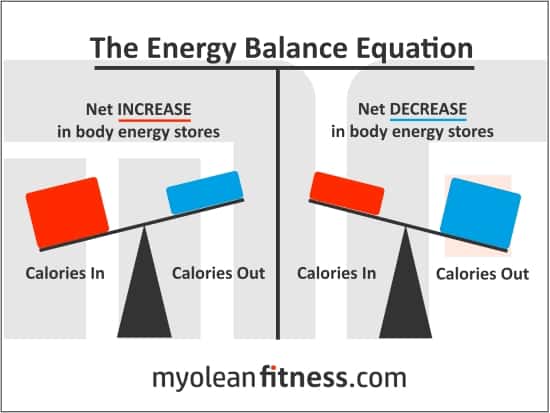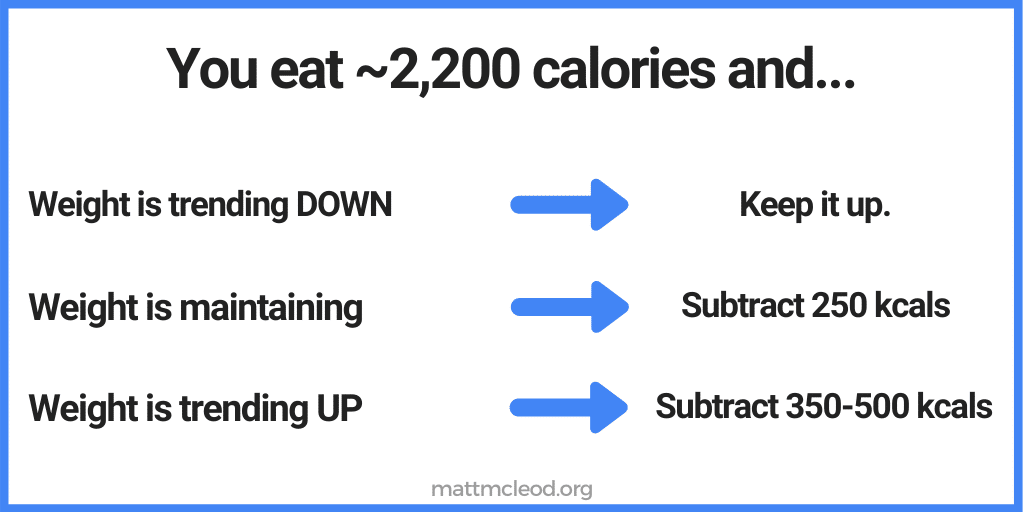EVERYBODY IS TALKING ABOUT IT.
Unless you follow Dr. Oz, the #ketowarriors, or the descendants of Liver King — you’ve heard that a “calorie deficit” is the key to losing fat.
We’ll get into details later, but to refresh: a “calorie deficit” simply means your body is burning more calories than you’re consuming (i.e., calories out > calories in = weight loss (few exceptions)).
A “calorie surplus” means you’re burning fewer calories than you’re consuming (i.e., calories out < calories in = weight gain).
And if you’re eating at your “maintenance calories,” you’re burning around the same number of calories as you’re consuming (i.e., calories out = calories in = maintain stable weight).
Now, I could get deep into the minutia of calories in calories out and how your body “burns” calories, but you probably don’t give a shit about the science.
What you do give a shit about: me knowing the science and giving you the actionable steps to put into practice.
And that’s exactly what I’m gonna do, so take a quick glance at this pretty picture and let’s keep it moving.

That’s the why. Now, I’ll share the how.
For the record, this is exactly how I set up a calorie deficit for my online coaching clients, so listen up.
STEP 1: BUY SCALES.
Buy a bodyweight scale and a food scale. These are reasonably cheap and some of the best investments you can make for managing your body. Plus, there are two things human suck at: estimating and remembering data. In fact, one study on daily food reporting showed even dietitians to be off by up to 800 calories. Some non-dietitians were off by over 1,000 calories! So, yeah. Buy the scales so you don’t do this.
STEP 2: DOWNLOAD A FOOD TRACKING APP.
I recommend My Fitness Pal or Mike’s Macros or Fit Genie to my clients. Don’t use the macro calculator for any of them as that’s the point of this post ⏤ this way is more accurate. MFP might just be more accessible in terms of how to use the app for some people. However, another downside of MFP is their calories can be off with some of their foods due to user inputted data. Just make sure your total daily macros match up to your total daily calories and you’ll be good to go. Any tracking app or using a pad and pen (if you’re a neanderthal) will work just fine. We’ll cover your macros (proteins, carbs, and fats) in a bit.
STEP 3: EAT NORMALLY AND TRACK EVERYTHING.
Without drastically changing how you currently eat, track every single thing (very important this is accurate!) you put in your mouth for at least four days (preferably three weekdays and one weekend day). I say to eat normal because you want to find your current baseline. If you go changing everything you eat, you’ll skew your results. And when I say track everything, I mean EVERYTHING — alcohol, condiments, oils, drinks, supplements, butter, sauces, dessert, etc.
STEP 4: AVERAGE OUT YOUR BASELINE.
After tracking at least four days, find the average number of calories you ate during that time period.
For example:
- Day 1: 2,300 kcals
- Day 2: 2,100 kcals
- Day 3: 2,300 kcals
- Day 4: 2,100 kcals
Your average would be 2,200 kcals. (2300+2100+2300+2100=8800 ; 8800/4 days = 2200 kcals)
STEP 5: REMAIN CONSISTENT WITH TRACKING WEIGHT AND FOOD FOR 14 DAYS.
Try to hit within +/- 50 of that average calorie amount (2,150 – 2,250) every single day for the next 2 weeks (including weekends!) AND weigh yourself every day in the morning – before you eat and after you use the restroom. It’s important you try to mimic each day so you can get a realistic idea of what your “typical” intake and weight would look like, i.e., don’t do this during vacation.
STEP 6: ANALYZE WEIGHT TRENDS.
Given that you followed step 5 correctly, we should now see a trend in what your weight does based off how much food you’re eating. If you’re eating ~2,200 calories per day and your weight is trending downward (not down every single day because weight fluctuates) over the course of two weeks — you’re likely in a calorie deficit. If your weight is staying about the same (within a pound or so), subtract 250 calories from your daily calorie goal and keep consistent. This means you are eating around your maintenance calories. If your weight is trending upward, take away 350-500 calories per day (you’re in a calorie surplus).

To be fair, these are only estimates and there are more indicators of fat loss than just using your scale weight. However, research has shown it’s a pretty damn reliable tool when determining a calorie deficit. I also have my clients take measurements bi-weekly, compare old clothes/belts, and/or take pictures every 4 weeks to compare. If those tools suit your fancy more than the scale, go right ahead. Just be objective as possible.
And that’s it!
Now you just have to use trial-and-error to see what is going to work for you in the long run. But this should at least help you determine a baseline. In my opinion, this works much better than a random macro calculator because it’s completely individual to you and your current eating habits.
Once you’ve figured out your calories, read my article here to figure out what to do next.
Last thing…
Now, if you’re anything like me, you read this and think, “I can probably figure out how to do that myself.”
And, like me, you’re probably right.
Ambition isn’t your problem, but opportunity cost is.
When doing it on your own, you risk:
- Turning your bad habits now into lifelong bad habits
- Losing confidence because of repeated failed attempts (then blaming yourself)
- Wasting time that could be spent with loved ones, on hobbies, or learning new skills
- Not having a physique that matches who you are
A good way to know if you’re ready for help is to think about how many minutes you spend per day wishing something about your body, mindset, and/or daily habits was different.
I know what goes through your head because I talk to people like you every. single. day. They work with me and we figure it out, together.
And just like I’ve told myself in the past, maybe it’s time to get out of your own way.
Click here to see if my 1:1 coaching feels like a fit for you.
Talk soon,
-Matt

0 Comments